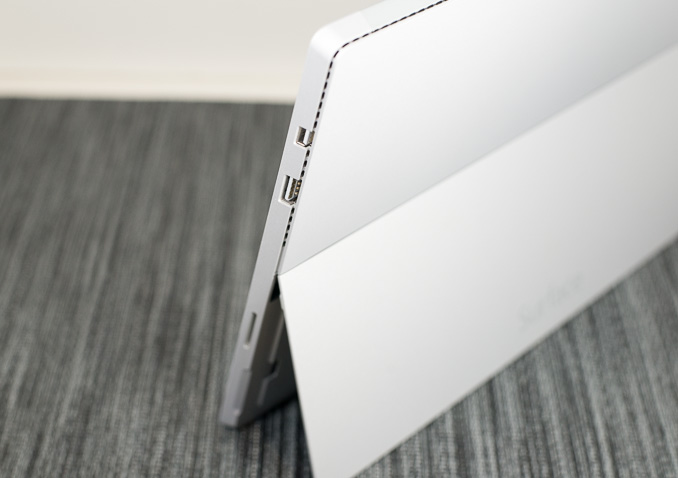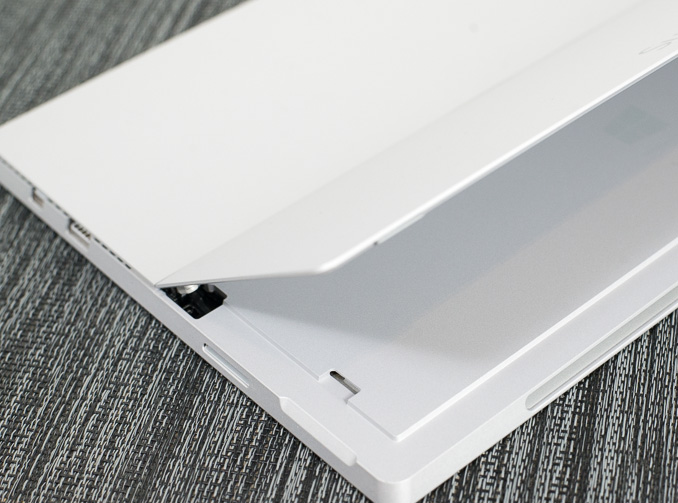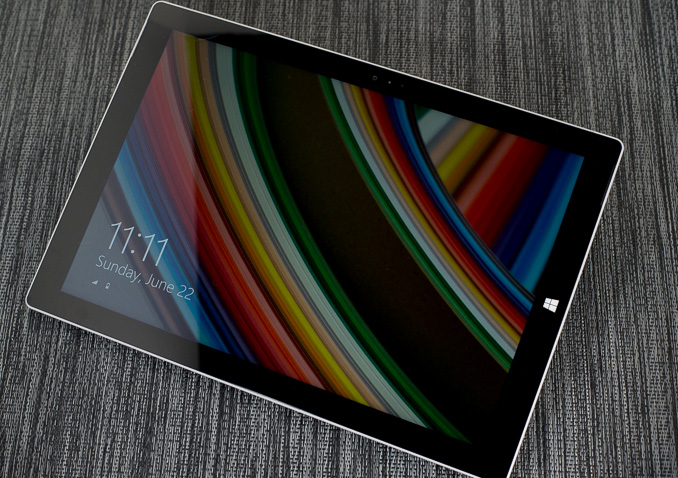Microsoft Surface Pro 3 Review
by Anand Lal Shimpi on June 23, 2014 3:55 AM ESTFinal Words
When I reviewed the first Surface Pro I was intrigued by the idea, but felt it needed a few more iterations to get to the right point. In less than two years what we have in front of us looks very different than Microsoft's original vision for the platform. Display size, aspect ratio and even the mechanics of the whole thing are all quite different. The changes are for the better as Surface Pro 3 is a much better laptop and a much better tablet than any of its predecessors. The device no longer feels cramped and tiring to use as a laptop. The new Surface Pro no longer feels heavy to use as a tablet either. It's truly an improvement on both vectors.
Microsoft might be overselling the design to say that it truly is the only device you need. Like most compromises, Surface Pro 3 isn't the world's best laptop nor is it the world's best tablet. It serves a user who wants a little of column A and a little of column B.
The device's "lapability" is tremendously better than any of its predecessors. While I wrote all of the previous Surface reviews on the very Surface devices I was reviewing, this is by far the most comfortable one to use as a laptop. It's still not perfect, and you still need a fairly long lap to make it work, but the design is finally really usable as a laptop.
As a tablet the thinner and lighter chassis is much appreciated. The new kickstand remains one of the best parts of the design, enabling a flexibility unmatched by any other tablet. Tent mode in particular is awesome for tablet usage models.
Surprisingly enough the move away from Wacom to an active NTrig pen model comes with very few issues. The device could use some tuning of its pen pressure curves. Applying max pressure on the screen now distorts the LCD, something I'm never comfortable doing. But overall the new pen gives up very little and even improves performance and functionality.
The new Type Cover is awesome. The keyboard is probably as good as it's going to get, and the new trackpad is finally usable. The latter isn't perfect but it's so much better than anything that's come before it.
The device also launches with a far more polished version of Windows. With its latest updates, Windows 8.1 is a far cry from where it first started. I still think there's lots of room for improvement, but it's clear that Microsoft is marching towards a more cohesive vision of modern and desktop Windows UIs.
The downsides for Surface Pro 3 are obvious. Windows 8.1 remains a better desktop/notebook OS than a tablet OS. Yet in a device like Surface Pro 3 where you're forced to rely on touch more thanks to a cramped trackpad, I'm often in a situation where I'm interacting with the Windows desktop using the touchscreen - a situation that rarely ends well. As Microsoft improves the behavior of its modern UI apps, I would love to see a rethinking of what touch looks like on the desktop. If Surface Pro 3 exists to blur the lines between laptop and tablet, Windows 9 needs to do a better job of the same. The desktop needs to react better to touch and the modern apps need to feel even more integrated into the desktop.
On the hardware side, the device is a compromise. You have to be willing to give up some "lapability" in order to get a unified laptop/tablet device. Whether what you get as a tablet is worth the tradeoff is going to be up to how good of a tablet OS Windows 8.1 is for you. Personally I find that Android and iOS deliver better tablet experiences particularly when it comes to 3rd party applications. If everything you need on the tablet front is available in the Windows Store however then the point is moot.
Those users upgrading from Surface Pro 2 may notice a regression in performance, particularly when it comes to running prolonged CPU/GPU intensive workloads. In games, the difference can be noticeable. The simple fact is that in becoming a thinner device, Surface Pro 3 inherited more thermal constraints than its predecessors. While performance regressions aren't ideal, in this case I can appreciate what Microsoft has done. From the very beginning I wanted a lower TDP part in a thinner chassis. Had Microsoft done that from the start we wouldn't have seen any performance regression but rather a steady increase over time. From my perspective, Surface Pro 3 is simply arriving at the right balance of thermals and performance - the previous designs aimed too high on the performance curve and required an unreasonably large chassis as a result.
The remaining nitpicks are the same as last time: Microsoft needs to embrace Thunderbolt, and a Type Cover should come with the device. The display's color accuracy is good but grayscale performance needs some work.
Surface Pro 3 is easily the best design Microsoft has put forward. If you were intrigued by the previous designs, this is the first one that should really tempt you over. I was a fan of the original Surface Pro, and with Surface Pro 3 I think Microsoft has taken the hardware much closer to perfection. At this point the design needs more help on the software side than hardware, which is saying a lot for the Surface Pro hardware team. Personally I'd still rather carry a good notebook and a lightweight tablet, but if you are looking for a single device this is literally the only thing on the market that's worth considering. I don't know how big the professional productivity tablet market is, but it's a space that Microsoft seems to have almost exclusive reign over with its Surface line. With its latest iteration, Microsoft is serving that market better than ever.













274 Comments
View All Comments
Drumsticks - Monday, June 23, 2014 - link
Heavier isn't a bad thing. The SP pen is light in my opinion, I've yet to see somebody say the pen was uncomfortable. Again, on the pen, from above:"Overall I have to say the new pen is an improvement. You get a much thinner display, an unnoticeable impact to pressure sensitivity, improved latency and the experiential improvements are substantial (one click wake/OneNote launch is useful)."
I'm not saying this as an artist. But as a user, note taking (which is my primary thing as a college student) seems to be improved.
Upgrade the GPU to what? They weren't going to get dedicated graphics in here, and the i7 model uses an HD5000. The throttling is meh, as Anand again mentioned.
I'm not saying it's perfect. I want this with Broadwell, badly. But it's a big improvement. It's not like it's going to be lacking for performance for what it's needed for. I don't expect mobile gaming out of this device, and that's the only time it really saw throttling.
ymcpa - Monday, June 23, 2014 - link
Most reviews praised the pen for being heavier and more comfortable to hold than the original pen. Gabe from penny arcade never mentioned that the N-Trig was less accurate. I will take an artist opinion over yours. I have read several reviews where it was stated that the Wacom digitizer in the pro 2 wasn't very accurate near the edges.mkozakewich - Monday, June 30, 2014 - link
As someone who's suffering with the edges of my Pro, I'd like to hear about how the NTrig handles around the edges. As it's a different technology and doesn't rely on something behind the screen, I don't think there'll be any problems.Imaginer - Tuesday, June 24, 2014 - link
As an artist, and someone who regularly uses OneNote for notes on a previous Surface Pro 2, and after using a Surface Pro 3...With Wacom pens, they are hefty like a light pencil, and handle as such. The N-Trig pen of the Surface Pro 3, feels like a quality solid inking pen in weight.
The time measured lag, is for long, prolonged strokes of quick length, instead of short and slow velocity movements. Most of the time, in writing, one isn't writing in big letters. The only time this MAY come up, is one doing quick, very long lines of strokes. Most of the time in drawing, such strokes are not too often and few in between in sketching and painting.
My only gripe, is that with the default Pro 2's pen, is that the eraser end is pressure sensitive as well, and can be flipped to erase. The Pro 3's pen, uses a second button on the side for erasing, which isn't as comfortable for me, and an adjustment of such. Here is hoping a second more "pencil" like pen that has a pressure eraser end is released. (along with lack of Wacom's radial like menu).
In the forums, I made an image showing handwriting aspects of pen comparisons - something that I felt would be a nice touch in the pen mentions - as it is not hard to pull a comparison between the two.
ymcpa - Monday, June 23, 2014 - link
This was explained by Microsoft. A human can't possibly replicate 1028 points of pressure. They can't even replicate the 256 points that the N-trig has. It's really about the pressure curve that they use. Microsoft said they will have an update that will allow users to alter the pressure curve to fit their usage.basroil - Tuesday, June 24, 2014 - link
No, Microsoft explained that even though Wacom's pen supports 1024bit, the actual useful resolution is much smaller because of how the pressure curve is set up (it's linear rather than semi-exponential like the n-trig)basroil - Tuesday, June 24, 2014 - link
1024 levels (10bit), not 1024bit (which would be a ridiculous number)ymcpa - Tuesday, June 24, 2014 - link
They talked about the pressure curve but the blog also mentioned that the human hand can't reproduce 1024 different levels of pressure. That is why it won't matter if the N-trig digitizer has less levels of pressure.theuglyman0war - Wednesday, June 25, 2014 - link
Even if an artist can not replicate 1024 levels of pressure in a single stroke ( wonder how u prove as much as humans are scary amazing beings at times ) An artist can easily need as much "threshold" in many stokes... Working very light where details build up in whispers. In which case 256 levels unutilized is complete hogwash.mkozakewich - Monday, June 30, 2014 - link
It's not even about what the artist touches on themselves, and more about the range. I'd like my pen to to be able to step from size 1 to size 255 in 1-step increments, in which case the sensitivity levels would work fine and I'd still have a pen with a massive brush. (Honestly, I'd probably not use 255 levels. More like 64.)